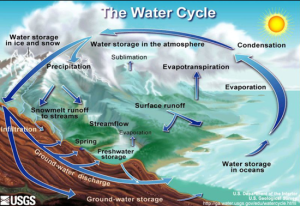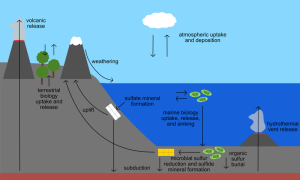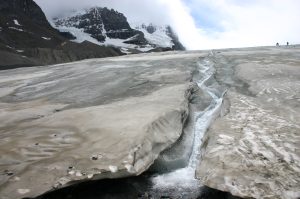2
By Isabella Cloves, Katherine Corbin, and Frank Ford
Abstract
The hydrosphere holds a major role on Earth and is vital to sustain all life present. Climate change has had a large influence on the hydrosphere, resulting in countless negative outcomes. The burning of fossil fuels has significantly changed the entire world including the hydrosphere by causing atmospheric CO2 levels to rise. Skyrocketing CO2 levels have not only influenced the warming of the planet, which has led to melting of Arctic ice, rising sea levels, a warming ocean and the bleaching of the coral reefs, but they have also produced an increase in the pH level of the ocean. These trends and many more predict a dire future for the health of the hydrosphere and the vitality of the Earth as a whole.
The Hydrosphere
The hydrosphere is the climate system on Earth which includes every body of water. Water is the most widespread substance on the planet, and is connected to all of the various climate systems on Earth. The water provided by the hydrosphere is one of the main components of the life support system present on Earth and it is an essential component for the self-reproducing life. The hydrosphere also includes the water cycle that involves the movement of water through different phases (Fig 1). Earth has an abundance of water that makes it unique to other planets. Human interactions and climate change have greatly influenced the hydrosphere (Kundzewicz, 2008). The leading causes of this change include the burning of fossil fuels, nitrate pollution, and the absorption of CO2 into the atmosphere. These changes to the hydrosphere have only amplified global warming more.

As a result of the changes caused by climate change, glaciers have melted and different bodies of water present on Earth have all been impacted significantly. In regards to human interactions with the environment, the atmosphere and the hydrosphere are both greatly experiencing the consequences from the burning of fossil fuels. Once all of the fossil fuels present on Earth have been used, the effect from burning these fossil fuels and the emissions produced will cause irreversible damage to the hydrosphere from which the planet will not be able to recover (Valero et al., 2011). The hydrosphere plays such an important role on Earth as it supports and sustains life. Nitrogen pollution has also harmed the hydrosphere. The nitrogen pollution in the hydrosphere is caused by the mineralization of soil nitrogen, fertilizer, and animal or sewage wastes (Heaton, 1986).
As the burning of fossil fuels spews an excess of carbon dioxide into the atmosphere, some of the excess is absorbed into the ocean. Carbonic acid is formed when the CO2 reacts with water, lowering the pH level of the seawater and making the ocean more acidic. As of 2013, the level was 0.1 pH lower than the pH level during pre-industrial times (Barford, 2013). The acidity of the ocean greatly affects the organisms living within it and many suffer as the water grows more acidic. One of those organisms affected is the very vital phytoplankton; microscopic organisms that photosynthesize to create energy. Phytoplankton make up the bottom of the food chain in the complex food webs that are present in the ocean. These phytoplankton also release dimethyl sulfide (DMS), which makes its way into the atmosphere and produces sulfuric acid (Barford, 2013). Sulfuric acid is considered a light aerosol and helps to form clouds in the atmosphere that reflect solar radiation rather than hold it in as greenhouse gases do (Osorio et al., 2008, Fig 2). If the production of DMS could increase as the CO2 levels in the atmosphere increased, then it would create a negative-feedback loop, regulating the effects of climate change. However, that is not the case. The acidity of the ocean harms the phytoplankton and less DMS is produced. The reality is a positive-feedback loop in which the excess amount of CO2 causes the Earth to warm, makes the ocean more acidic, lowers the amount of atmospheric sulfur, and impedes the natural cooling effect from light aerosols, therefore increasing global warming even more. DMS production does increase in warmer waters yet the damaging effects of an acidic ocean overpower any increase in production due to higher temperatures (Barford, 2013).

The impacts of climate change can be seen more clearly in specific parts of the hydrosphere. One special case, the Lake Baikal, located in southern Siberia, Russia, is experiencing strong climate change effects. Lake Baikal is the most biodiverse lake in the world due to the oxygen present in its depths and holds 20% of the world’s liquid freshwater (Moore et al., 2009). Its location has extremely cold winters and is one of a few regions of Earth experiencing the most significant effects of climate change, with a 1.2 degrees Celsius increase in temperature over a century (Moore et al., 2009). This temperature change greatly affects the abiotic processes that are essential for maintaining the lake’s current state and organisms. A warmer winter leads to less ice cover which reduces ideal conditions for the bloom of phytoplankton in the spring. This altered climate is also predicted to have an increase in snowfall which will cover the ice and block light from entering the water, further harming the phytoplankton bloom. Since phytoplankton provide much of the energy for aquatic life through photosynthesis, this effect is devastating to all the diverse life in Lake Baikal. With less ice cover, the water is also exposed to the warmer air and therefore the surface temperature of the lake increases. Smaller photosynthetic organisms thrive in the warmer temperatures therefore bigger photosynthetic organisms are slowly phased out, leading to a lower energy production (Moore et al., 2009). Fish that thrive in colder water have to retreat deeper in the lake which disrupts the food chain by separating predators from prey. Wind patterns in the area change as well, causing the stratification of the lake water to change, leaving sections of the lake lacking in oxygen (Moore et al., 2009). These examples and many more show that climate change in Lake Baikal attacks from all angles and will have tremendous effects on the life that has occupied this lake for centuries.
Changes in the hydrosphere greatly affect the organisms that inhabit it. Fish and other marine life have been greatly impacted by climate change and its negative influences on the hydrosphere (Roessig et al., 2004). A key indicator of damage being done is seen in the melting of glaciers. The abundance of freshwater flowing into the ocean from melting glaciers can affect the ocean’s circulation, changing how seawater moves across the world and affecting ecosystems and many human activities such as agriculture (Dyurgerov & Meier, 2005). The glacier runoff also causes a rise in sea-level which could devastate coastal communities. In a single year, between 2018 and 2019, there was a global rise in sea level of 0.24 inches (Lindsey, 2020). This incredibly rapid rate continues to increase each year. So why do scientists care so much about the rising waters? One reason is that many people reside on the coast, including forty percent of the US population (Lindsey, 2020). Millions of people’s lives could be uprooted if the sea level reaches a high enough point. Even if floods don’t lead to the demise of some cities, the saltwater can still contaminate drinking water and there will be less natural protection from storms. Rising ocean water is a well-known result of melting ice, yet it creates many of these extra problems that often go unmentioned.

In addition to the changes brought on by melting glaciers, changes can be observed below the sea in one of the most important aspects of the ocean; the coral reefs. The coral reefs provide shore protection for coastal communities and jobs for locals in the area through fishing, recreation, and tourism. Additionally, they provide shelter for fish during the day and a hunting ground for them at night. The warming of the Earth’s oceans has already caused catastrophic coral bleaching events and as the oceans continue to warm these events will occur more frequently (Mumby et al., 2011). Bleaching of the coral reefs results in a loss of vital habitat for many different species of fish and financial loss for coastal towns. After a thorough analysis of future ocean temperatures it has been determined that a ‘quick’ increase of one to two degrees Celsius in the ocean would not allow for coral reefs to acclimate or adapt. This would therefore result in the death or bleaching of many reefs worldwide. All coral reefs have a limit to what fluctuations in ocean temperature they can survive. The predicted increase in oceanic temperature would pass the threshold of survival for a majority of coral reefs (Mumby et al., 2011). Once this threshold is exceeded, coral reefs will begin to die and this loss will be irreversible. While coral reefs can and will try to adapt to changes in ocean temperature, the quickness of future warming trends will not allow for thorough adaption, resulting in an enormous loss of the coral reef ecosystem.
Overall, the hydrosphere has been greatly affected by climate change. The burning of fossil fuels and nitrogen pollution have both had an impact on the hydrosphere. This has caused bodies of water to become more acidic due to higher amounts of CO2 and negatively affect the species that inhabit it. Coral reefs have also been negatively impacted, harming the species that inhabit them as well. This change has also caused glaciers to melt and affect the hydrosphere’s processes. The results of climate change have strongly impacted the hydrosphere and the organisms that rely on it and could soon wreak havoc on human activities.
References
Barford, E. (2013, August 25). Rising ocean acidity will exacerbate global warming. Nature. https://doi.org/10.1038/nature.2013.13602
Dyurgerov, M. B., & Meier, M. F. (2005) Glaciers and the changing Earth system: A 2004 snapshot. Occasional Paper, 58. University of Colorado http://instaar.colorado.edu/uploads/occasional-papers/OP58_dyurgerov_meier.pdf
Heaton, T. H. E. (1986). Isotopic studies of nitrogen pollution in the hydrosphere and atmosphere: A review. Chemical Geology: Isotope Geoscience, 59, 87-102. https://doi.org/10.1016/0168-9622(86)90059-X
Kundzewicz, Z. W. (2008). Hydrosphere. In Encyclopedia of Ecology, pp. 1923-1930. https://doi.org/10.1016/B978-008045405-4.00740-0
Lindsey, R., (2020). Climate change: Global sea level. NOAA Climate.gov. https://www.climate.gov/news-features/understanding-climate/climate-change-global-sea-level
Moore, M. V., Hampton, S. E., Izmest’eva, L. R., Silow, E. A., Peshkova, E. V., & Pavlov, B. K. (2009). Climate change and the world’s “Sacred-Sea”- Lake Baikal, Siberia. Bioscience, 59, 405-417. https://doi.org/10.1525/bio.2009.59.5.8
Mumby, P. J., Elliott, I. A., Eakin, C. M., Skirving, W., Paris, C. B., Edwards, H. J., Enríquez, S., Iglesias-Prieto, R., Cherubin, L. M., & Stevens, J. R. (2011). Reserve design for uncertain responses of coral reefs to climate change. Ecology Letters, 14(2), 132–140. https://doi.org/10.1111/j.1461-0248.2010.01562.x
Osorio, J., Mendoza, B., & Velasco, V. (2008). Methane sulphonic acid trend associated with beryllium-10 and solar irradiance. Proceedings of the 30th International Cosmic Ray Conference, 1, 501-504. https://indico.nucleares.unam.mx/event/4/session/40/contribution/740/material/paper/0.pdf
Roessig, J., Woodley, C., Cech, Jr, J., & Hansen, L. (2004). Effects of global climate change on marine and estuarine fishes and fisheries. Reviews in Fish Biology and Fisheries, 14(2), 251–275. https://doi.org/10.1007/s11160-004-6749-0
Valero, A., Agudelo, A., & Valero, A. (2011). The crepuscular planet. A model for the exhausted atmosphere and hydrosphere. Energy, 36(6), 3745-3753. https://doi.org/10.1016/j.energy.2010.07.017
